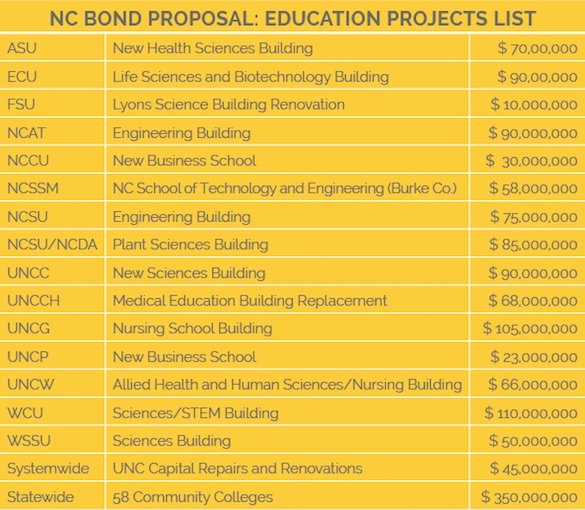You don’t add 2 million people without scaling up.
Two million people have moved here since the last state bond referendum in 2000.1 The Connect NC bonds on the ballot Tuesday are a modest effort to build educational capacity for a state of 10 million people that’s now the 9th-largest.
The bonds amount to $2 billion, two-thirds of it for our public universities and community colleges to expand in STEM fields. State parks, the NC Zoo, the National Guard, and rural water and sewer systems would also benefit.2
The expansion is needed both because we have more people in North Carolina and because more of us demand an education.
Workers need a degree these days to land a stable job: The Georgetown Center on Education and the Workforce projects that by 2020, 65% of U.S. jobs will require higher education.3 North Carolina’s public universities now enroll 225,000 students,4 and its community colleges more than 800,000.5
More than $1 billion in university bond projects focus on high-demand fields:
- Health/Medicine/Nursing at UNC-CH, UNCG, ASU and UNCW.
- Engineering at NCSU, NCA&T and UNCA.
- Sciences at UNCC, NCSU, ECU, WCU, WSSU, FSU and NCSSM.
- Business at NCCU and UNCP.6
It’s about making room for students – our children and grandchildren – in those fields.
“We’re turning away 140 qualified nursing students every year,” says UNC Greensboro Chancellor Franklin Gilliam. “Cone Health tells us we cannot produce nurses fast enough for them to hire.”7
Similarly, community colleges would receive $350 million for needed repairs and expansions to help more students succeed, whether by mastering a new skill or transferring to a four-year school.
“If we want to live well, we have to educate well,” says Tony Zeiss, President of Central Piedmont Community College. “People say the cost of education is high. Yes, but the cost of ignorance is worse.”8
It’s about Connecting North Carolina with the future.
State officials are adamant that no tax increase is required to pay off the bonds.
In fact, North Carolina is paying down debt so steadily that even with the bonds, the state is projected to face half a billion dollars less debt in five years than it does today.9
The amount is indeed modest.
To put it in context, Duke University alone has devoted $2 billion to new construction and another $1.7 billion to its health system over the past 10 years. By comparison, the Connect NC bonds would provide $1.4 billion to be spread across 17 university campuses and 58 community colleges.10
The bond proposal appears at the bottom of many primary ballots – or on the back, depending on the number of local races.
So don’t miss it. Don’t make excuses. Don’t sit out an important decision about our future.
Go vote.
1 http://www.higheredworks.org/2016/01/2b-bonds-nc-stepping-up-to-the-future/.
2 Ibid.
3 https://cew.georgetown.edu/wp-content/uploads/2014/11/Recovery2020.ES_.Web_.pdf, p. 3.
4 http://www.journalnow.com/news/state_region_ap/nc-public-universities-break-record-at-nearly-k-students/article_f12e5ac1-c23e-59df-bbe2-a8e6ebe7fa76.html
5 http://www.nccommunitycolleges.edu/success-stories/sean-ross.
6 http://www.ncleg.net/Sessions/2015/Bills/House/PDF/H943v8.pdf, pp. 3-4.
7 http://www.higheredworks.org/2016/01/uncg-chancellor-we-need-those-workers/
8 http://www.charlotteobserver.com/news/local/article65064382.html.
9 http://connect.nc.gov/Final%20Bond%20Presentation_12.10.15.pdf, Slide 6.
10 Duke University, Vice President for Public Affairs and Government Relations, February 19, 2016.


Leave a Reply